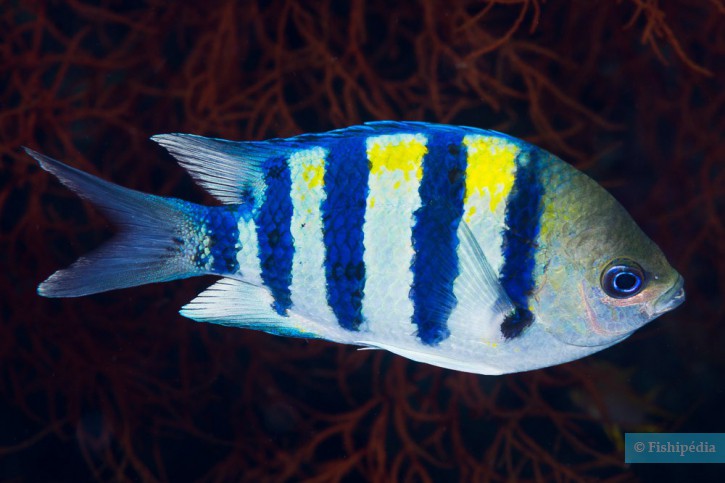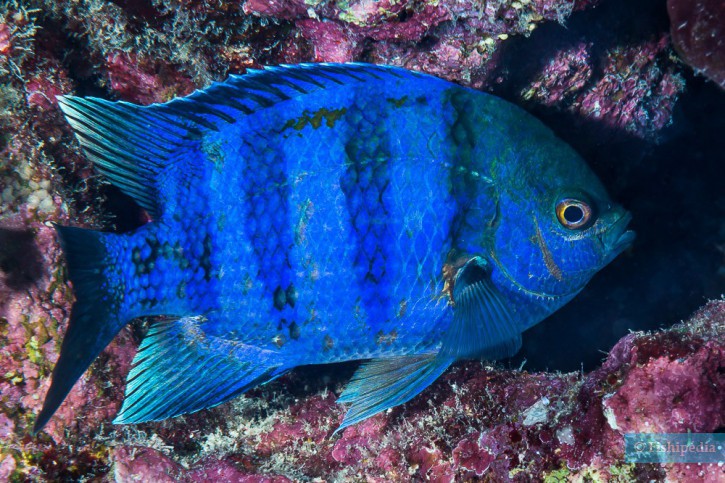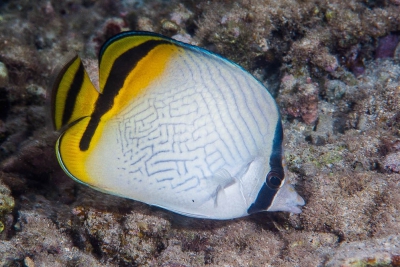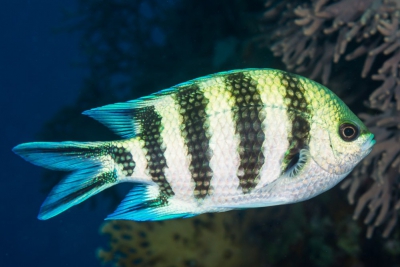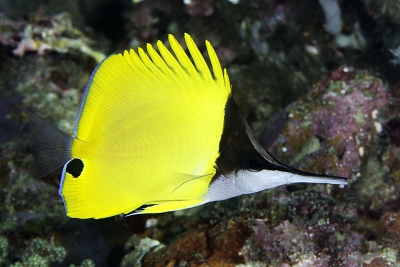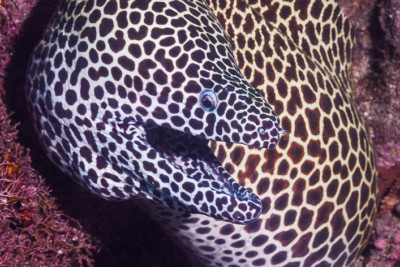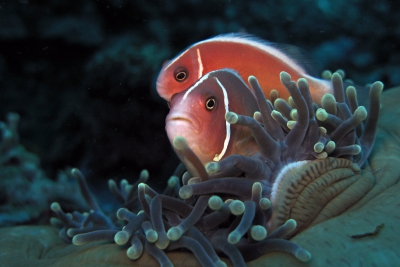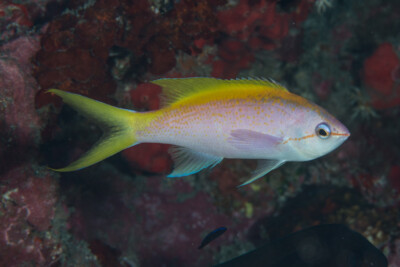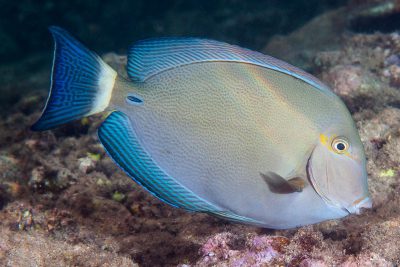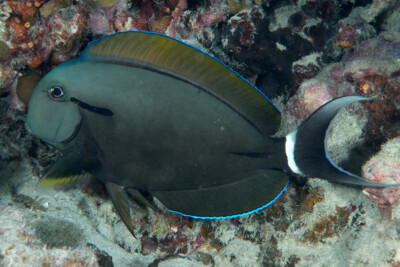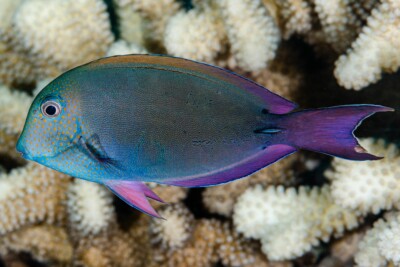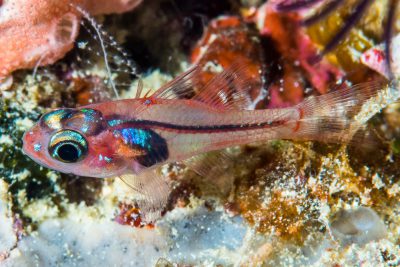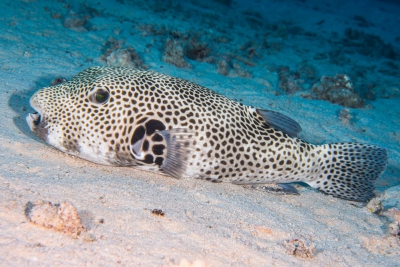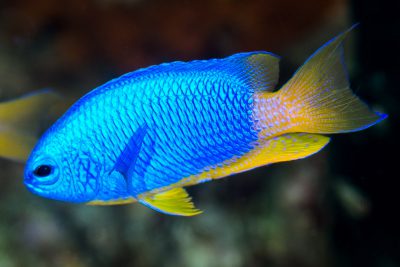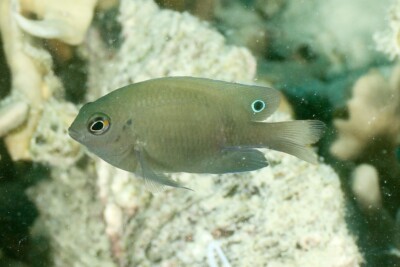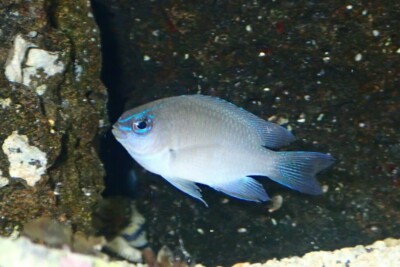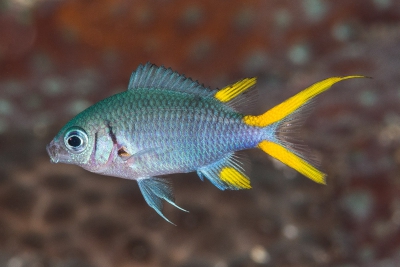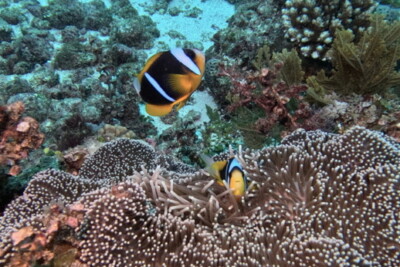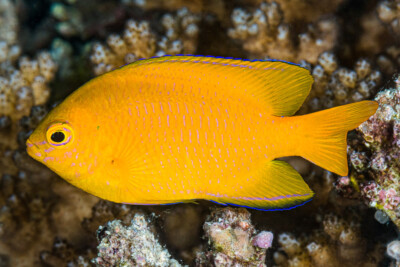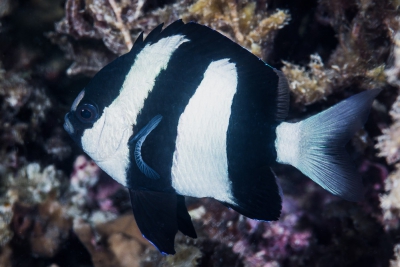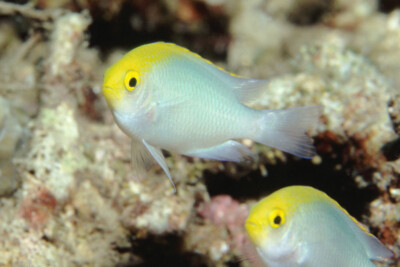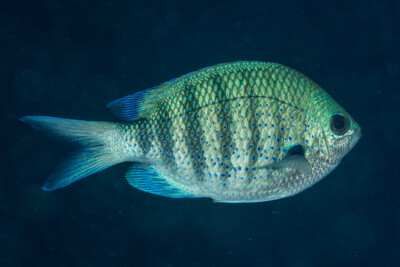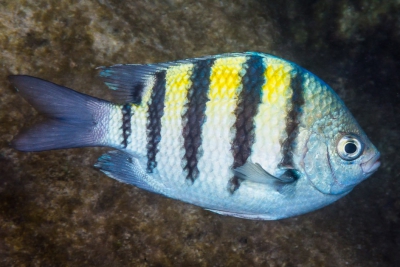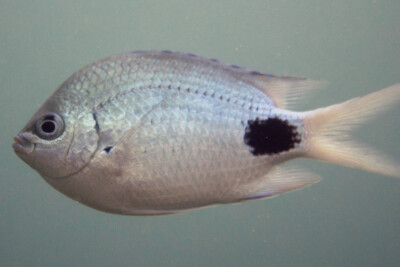five-banded sergeant-major
| Scientific name | Abudefduf vaigiensis |
|---|---|
| Descriptor | Quoy & Gaimard |
| Year of description | 1825 |
| IUCN category (World) | LC |
| Family | Pomacentridae |
| Genus | Abudefduf |
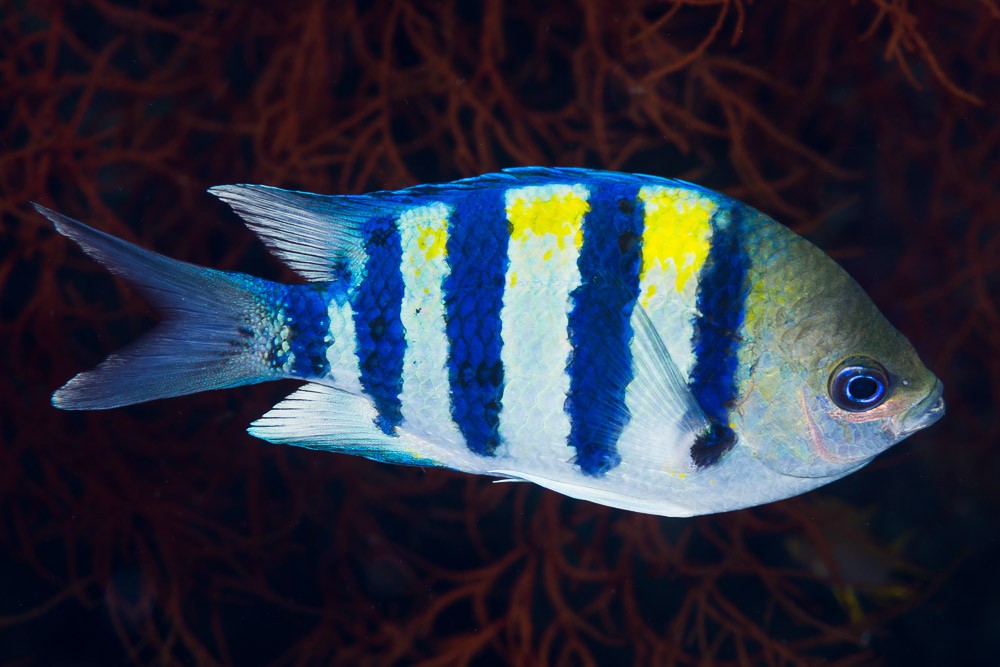

Introduction
Abudefduf vaigiensis, more commonly known as the five-banded sergeant-major, is a tropical fish found from the Red Sea to the Pacific Ocean.
Who is it?
Morphology
-
Average size20 cm
-
Maximum size22 cm
-
Longevity10 year
-
ShapeOvoid
-
Patternvertical stripes
-
Average size20 cm
-
Maximum size22 cm
-
Longevity10 year
-
ShapeOvoid
-
Patternvertical stripes
How to recognize This fish ?
The five-banded sergeant-major is tricolored with a mainly blue/black, yellow, and white body. It has dark blue vertical stripes.
This fish is born male. As it grows, some individuals will change sex to become female, a phenomenon known as protandrous successive hermaphroditism.
Sexual dimorphism
Dimorphism not specified.
Behaviour & Life cycle
-
dietomnivorous with carnivorous tendency
-
Sociabilitygregarious
-
territorialYes
-
Way of livingdiurnal
The five-banded sergeant-major is a fish that lives in large groups and naturally stays close to the bottom. It has a rather lively temperament.
The five-banded sergeant-major is a highly territorial fish that does not tolerate any intrusion in its territory. It is very aggressive towards other territorial species and can engage in intense fights to dominate its neighbors. It is generally more tolerant towards non-territorial fish. During the breeding season, it becomes even more aggressive, potentially causing injuries to any fish that poses a threat to its offspring.
Reproduction
-
Reproductionovipare qui pond sur substrat découvert
-
Hermaphroditeprotandric
The five-banded sergeant-major is an oviparous fish that deposits its eggs on exposed substrate.
Harmless species
This species does not represent any particular threats to humans when encountered in its natural environment.
Origin and distribution

What is its habitat?
Natural environment characteristics
-
Temperature22 - 26 °C
-
Depth0 - 15 m
-
FlowStrong and Medium
Biotope presentation
This species is most commonly found at depths shallower than 15m. However, it is not impossible to encounter this fish at other depths.
Species of the same biotope
Main recommendations for fishkeeping
Deontology
In order to preserve wildlife, if you acquire this animal, it must not be released into the wild. See also, the Fishipedia charter.
Fishipedia supports the practice of responsible and environmentally friendly aquarium keeping. We encourage maintenance if it is motivated by a desire to understand the biological functioning of living things and if it is done with respect for animal life.
We believe that aquaristics is an opening to the discovery of aquatic environments, especially freshwater, and that this knowledge is necessary to better protect and respect these environments. Logically, we refute the compulsive purchase of animals that would not find a sufficient and / or adapted place in the host aquarium.
Our recommendationsThese tips apply to adult species from breeding. With regards to water conditions, wild species or close relatives must be kept under the same conditions as in their area of origin.
-
Min volume600 liters
-
Population min2
-
Temperature22 - 26 °C
CharacteristicsThe characteristics below apply for adult species. They correspond to an average of cases, validated in maintenance condition.
-
Difficulty breedingThe farming difficulty is relative. It depends on experiments already carried out with similar species. First, it takes into consideration the robustness of the species, the ease of recreation of a favorable environment and the general behaviour with the other inhabitants of the aquarium.easy
-
Robustnessrobust
-
Behaviourvery aggressive
-
Availabilityrare
General reminders
It is strongly advised to read the complete dedicated file and to get information on the feedbacks of maintenance of the envisaged animal, this to avoid any potential conflict whose end result is generally the death of the individual (or the other inhabitants). It is important not to overload your aquarium to limit pollution. This will make maintenance easier.
General reminder on maintenance datas
Le démarrage d'un aquarium est une partie primordiale pour l'équilibre et le bien-être des poissons. Lorsque l'on met en eau un aquarium, l'eau passe naturellement par un cycle biologique : le cycle de l'azote. Celui-ci dure environ trois semaines. Tous les 2 jours, nous vous conseillons de tester votre eau jusqu'à ce que le taux de nitrite soit à zéro pendant plusieurs jours d'affilée.
Pour accélérer ce cycle, vous pouvez utiliser un activateur de bactéries comme JBL Denitrol. Cette solution riche en bactéries vivantes et enzymes permet une mise en place rapide du cycle de l'azote. Les poissons peuvent alors être introduits plus rapidement.
Il est important de tester l'eau de son aquarium régulièrement pour maintenir un environnement sain pour les poissons et les autres habitants. Les tests d'eau permettent de mesurer les niveaux de différents paramètres tels que le pH, la dureté totale, ainsi que les taux de nitrates, de nitrites et d'ammoniaque.
Pour réaliser ces tests, vous pouvez utiliser des produits d'analyse spécialisés tels que JBL ProScan qui permet de réaliser un diagnostic de l'eau directement via un smartphone. Il existe également des coffrets de tests plus classiques de bandelettes, comme JBL PROAQUATEST.
En cas d’usage de l’eau du robinet, vous pouvez utiliser un conditionneur d’eau de type Biotopol de JBL pour éliminer les substances nocives comme le chlore, le cuivre, le plomb et le zinc. Les conditionneurs d'eau garantissent une meilleure santé aux poissons et une meilleure croissance des plantes.
Chlorine and chloramine are dangerous for the health of animals. Used to disinfect water, these agents are present in significant quantities in tap water. We recommend using an anti-chlorine agent every time you change the water. In addition to chlorine, treatments and medicines sold for aquarium use sometimes contain dangerous heavy metals in high doses.
Specific needs for the five-banded sergeant-major
The five-banded sergeant-major is a marine species which lives naturally at a temperature between 22 °C and 26 °C. For proper maintenance, the temperature should never exceed the 29°C for long periods. Nitrate levels should remain below 50mg/L. To keep the water clean and unpolluted, plan on changing 20% to 30% of the water volume each month. In seawater, it is also possible to remove nitrates using one of the following methods: Jaubert, denitrator on sulfur, biopeletts, vodka method.
Breeding this species is accessible to any hobbyist. It is recommended to follow some basic rules and to be rigorous to achieve a good maintenance.
This species is very rare in the aquarium trade. Instead, it is maintained by knowledgeable aquarists who own and breed individuals from wild origin strains. If you want to get this species, we advise you to contact specialized clubs. }Specimens from long time breeding are a bit easier to breed but you have to respect the particular water parameters.
Cohabitation & Environment
Being a gregarious fish, it is advisable to install at least 2 individuals in an aquarium of 600 liters minimum (for 150 cm of frontage). Group maintenance is a prerequisite to ensure their well-being. Lonely individuals tend to quickly become stressed and become especially susceptible to disease.
The five-banded sergeant-major has a very strong character. Few neighbors are able to stand up to it.
Its maintenance with other territorial species is very risky and has great chances to lead to drama. The choice of possible cohabitants must therefore be carefully considered and only in an appropriate context (large volume, refuges...).
The maintenance with conspecifics can also be complicated.
As previously said, The five-banded sergeant-major is a species that lives naturally in the current. Thus, we advise the installation of an oversized filtration system (10 to 20 times the volume of the tank) in order to guarantee a strong current and especially a strong oxygenation. A venturi system will improve the dissolved oxygen rate during summer.
Tips for feeding
The five-banded sergeant-major is omnivorous with carnivorous tendency.
This species can eat dry food (flakes, pellets), fresh food and frozen food. To avoid deficiencies, it is recommended to vary the types of food.
You should not overfeed your residents to avoid polluting the water. For most species, it is better to feed a few small portions each day rather than one large meal.
Reproduction protocol
-
Spawning cleaningMale
-
egg-laying protectionMale
-
Fry protection
Hybridization risks
In general, it is advised not to mix several species of the same genus or different varieties of the same species, to avoid the risks of hybridization.
These animals might interest you
To go further
Sources & Contributions
Participation & Validation
The Fishipedia team and specialist contributors are committed to providing high-quality content. However, although the information comes from scientific sources or testimonials from specialists, the cards may contain inaccuracies.

Benoit Chartrer

Adrien Falzon
Translation
Translation done with the valuable contribution of our translators, who make this information available to a wider audience. We sincerely thank them for their commitment.
Scientific partners
Tags
#Pomacentridae
#Abudefduf
#barrière de corail
#lagon
#Bay of Bengal
#Persian Gulf
#Great Barrier Reef
#mer d'Oman
#Philippine Sea
#Sea of Japan
#Red Sea
#South East Asian Seas
#Indonesian seas
#western Indian Ocean
#Western Tropical Pacific Ocean
#Bali
#Réunion
#Maldives
#Nusa Penida
#Zanzibar Archipelago
Species of the same family
Same genus
Species of the same biotope
